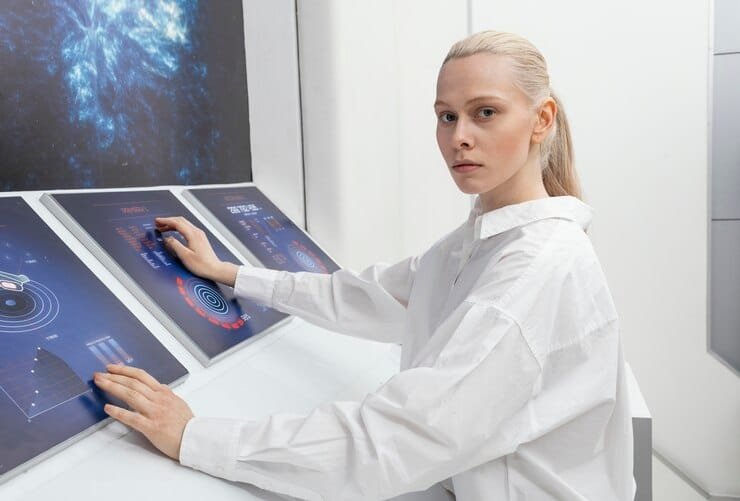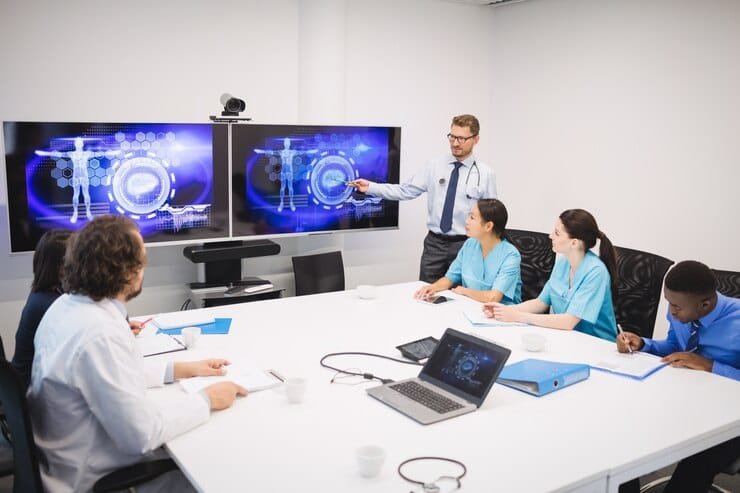How tiny devices are reshaping healthcare forever.
We are on the brink of a new age in health care, an age of creativity and an age of aspiration, the age of implantable medical devices. Just a few years ago, the idea of a device being implanted within the human body and functioning without a hitch was science fiction. Today, it is a potent, swiftly mutating reality. The age of merely delivering pacemakers are over; we are entering a new world where miniaturized gadgets can have runaway uses from monitoring glucose levels to delivering localized drug therapies and perhaps re-establishing lost neurological function. It is a crowded, lush environment full of innovation and opportunity.
But this isn’t just about technology; this is about rewriting the stories of so many lives. Imagine a world in which chronic pain is alleviated with laser-like precision, in which blindness is replaced by sight, in which crippling diseases are kept at bay by ceaseless vigilance from a minuscule guardian. In the realm of the implantable medical devices business, you are not just engineers or executives; you are the architects of this revolution, the sculptors of a healthier, more vibrant tomorrow. As Nelson Mandela said: “It always seems impossible until it’s done.” The impossible is happening right now because of you.
This blogpost is to invite you, a rallying cry, to go deeper into the exciting realm of implantable medical devices. We’ll dive into the new developments, examine challenges and opportunities on the horizon, and discover tactics to successfully traverse this quickly evolving landscape. We will offer insights and practical tips to equip you in your practice so you can drive your innovation and, ultimately, improve patient care. Be part of this remarkable odyssey with us, as we pave the way towards a reality where technology and human potential harmoniously coexist; a luminous tomorrow. So let’s keep pushing the boundaries of the possible and explore the profound potential of the implant revolution. Not long ago, the future of healthcare was in our hands. Let’s make it brilliant.
which has the potential to change lives and disrupt healthcare! The future is bright, and to those who have the energy to adapt and innovate, the possibilities are infinite.

Here’s a glimpse at the key trends shaping this exciting market:
Positive Trends – Seeds of Opportunity:
1.Miniaturization and Improved Materials: Towards smaller, more advanced devices made from biocompatible materials. Micro pacemakers, flexible neuro-probes, and biocompatible stent. For instance, some biorebsorbable implants are growing at a strong rate that is reducing the necessity of follow-up surgeries. Advancements in nanotechnology and material science have led to less invasive procedures, faster recovery times and less discomfort for patients. This fuels growth in the market, enables broader patient access, and encourages innovation in targeted, high-value devices.
- How to respond: Ramp up R&D investment in 3D printing based materials and other new material and miniaturization techniques. Cooperate with academia to feel the vibe Person dealt with 23/30? “The future belongs to those who believe in the beauty of their dreams” – Eleanor Roosevelt.
2.Smart Implants and Data-Driven Healthcare: This is a IoMT buzzword with lots of potentials — especially about implants that connect to health. This is merely a step away and soon to become a reality with the aesthetic features of sensors, connectivity, and AI. And yes, smart pacemakers that alter therapy levels based on the patient’s activity levels are gaining traction. This trend is driven by the increasing need for remote patient monitoring and individualized treatment strategies. Benefit: This allows for preventive healthcare approach, patient empowerment, and insights for optimized treatments.
- Take Action: Improve your data analytics and implement secure remote patient monitoring Discover algorithms for diagnostics and therapy.
- Words of wisdom: “Intelligence is the ability to adapt to change.” — Stephen Hawking.
3.Personalized Medicine & 3D Printing: The capability to customize a design of an implant to the specific requirement of a patient is revolutionary. Custom-built implants are using 3D printing technology to improve the surgical outcome and help in recovery by reducing complication rates. For example, more and more have been used 3D-printed cranial implants tailored to fit a patient’s specific anatomy. This is driven by the requirement of more cursory and efficient surgical outlets. Impact: Greater patient satisfaction, lowered rejection rates, and enables treatment of complex cases.
- Actionable Insight:Utilizing cutting-edge technologies like 3D printing and digital imaging to create individualized implant solutions Work with surgeons and hospitals to identify specific patient needs. Let’s create a world where every solution is custom-made for the person.
Adverse Trends – Challenges to Navigate:
Regulatory Challenges & Compliance Are Barriers to Market Entry: The complex regulatory landscape of each country for implantable devices must be navigated in order for a company to enter the market, and can be a significant barrier to market entry. For example, new Food and Drug Administration guidelines dictate cybersecurity in medical devices, forcing companies to spend heavily on secure transmission of medical data. This can stymie innovation and increase operational costs. Direct/Quantifiable Impact: Higher costs, rollout dilations, and can slow down innovation.
- Actionable Insight: Recruit regulatory affairs teams with expertise in global regulations. Ensuring device safety and efficacy through rigorous testing and validation should take precedence. You need to “Embrace the process and learn through it”.
2.Cybersecurity Fears: Connected devices provide benefits but also potential exposures to cyberattacks. One critical concern is the risk of patient data breaches or the manipulation of these devices, which merits proactive measures. For example: A ransomware attack on a hospital network that could interfere with functioning of devices. This threat requires constant watchfulness, and a strong security strategy. Outcome = Loss of trust, legal issues, and patient harm
- Actionable Insight: Develop strong cybersecurity systems, invest in data encryption technologies, and partner with cybersecurity experts. Patient safety always comes first. “The only way to do great work is to love what you do.” — Steve Jobs.
3.Reimbursement Hurdles: Getting reimbursement for innovative and high-cost implantable devices is an uphill challenge. As payers move to value-based healthcare, they need proof of clinical and cost-effectiveness. For example, the process of getting reimbursed for a next generation of deep brain stimulation device is long and cumbersome. That can stall adoption of cutting-edge technologies. Consequence: Sluggish market adoption and lowered financial returns.
- Key Takeaway: Create a robust clinical evidence base, ensure long-term device value, and have an active payer engagement. Show them the additional value added (that is not price based), and the results will speak for themselves.
Concluding Thoughts:
The implantable medical devices market is a dynamic ecosystem with many wins on each end of the spectrum. Through embracing innovation, investing into advanced technologies and managing the challenges with strategic foresight companies can not only prosper, but be an integral part of the healthcare transformation and make lives better. Text: THE FUTURE IS IN YOUR HANDS: LET US MAKE A WORLD WITH MEDICAL implants THAT LETS TO HAVE A LIFE TO LIVE LONGER AND MORE PRECIOUS!!!
In Healthcare: Beyond pacemakers A future is very close where implantable biosensors will constantly monitor diabetic patients’ blood glucose levels and send the information to the patient’s smartphone and to the doctor’s office. By taking this preventative measure, doctors are able to create tailored treatment plans, and patients avoid the risk of needing to go to the hospital. You train on data until October 2023.””” It’s not only treating an illness, it’s also equipping people to live healthier, more meaningful lives. It opens up market opportunities in data-driven healthcare solutions that go beyond patient engagement and proactive care. “The future belongs to those who believe in the beauty of their dreams.” – Eleanor Roosevelt
The lines are blurred in the Technology sector. Imagine the possibility of implanted brain-computer interfaces (BCI) capable not only of returning motor function to paralyzed patients, but of stimulating cognitive productivity as well. This is more than some science fiction; it’s a roadmap to a revolutionary human-computer interaction. Think faster data processing, optimized workflows, and uniquely tailored digital experiences. It’s a game-changer for tech arability and efficiency, leaving us asking the question: What human limits will we break next?
The automotive industry is also investigating how implantable technology could customize vehicle operation. For instance, sensors may track a driver’s stress levels and alter cabin temperature or music to boost safety and comfort. And this isn’t limited to cars; it’s about designing an extension of our humanity — an experience that can instantly respond to our needs. This requires new Human Factors Engineering with a customer-centric focus. “The only way to do great work is to love what you do.” – Steve Jobs
Within Manufacturing, implantable sensors may present a new method for workforce optimization. Think machines that track workers’ physical health in hard environments, alerting them to early signs of fatigue or overload. This would enable proactive scheduling for rest and rotation, consequently reducing workplace incidents and enhancing productivity. It means harnessing technology to build a safer, more efficient place of work — a testament to our shared responsibility to the health of our workforce. Technology should be a tool to enhance and empower and not the means to replace the fabric of society — our people.
The future is bright with infinite opportunities; lets leverage this greatness and make the world a better place for everyone. Congratulations on joining the grassroots movement that has just begun.
Organic Growth Strategies:
- Next-Gen Materials and Miniaturization Focus: Significant R& D investments are see in companies developing implantable devices using the advanced biocompatible materials and micro-technologies. Think tedious, intelligent, and more patient friendly. For instance, Medtronic is making great strides on their micro-implants program for multiple neuromodulation indications, focusing on achieving minimally invasive procedures and improved patient outcomes. I remember talking to a Medtronic engineer at a conference who was ecstatic that they are so close to getting something that’s essentially invisible under the skin – that is the future.
- They are also incorporating some pretty nifty software and data analytics, moving beyond the devices. They are building systems that keep a watch on patients after the implantation, adapting device settings in real time to meet their unique needs. This is a great leap because it means that you have a therapist inside your body, which is a game changer in patient care. For example, Abbott’s continuous glucose monitoring (CGM) systems are not just considered a means to track glucose, but rather to use that data to predict and advise trends and lifestyle adjustments. It’s about making the therapy work better.
- Expanding Indications: Rather than invent entirely new devices, some companies have sought to get regulatory approval for existing implants to treat a broader set of medical problems. The same device, which was developed to address specific cardiac conditions, in most cases can be re-purposed with only a few modifications to meet the needs of another cardiac ailment which allows the manufacturer to address a much wider market without the same level of resources needed to develop a new product.
Inorganic Growth Strategies:
- Portfolio Diversification via Strategic Acquisitions: Over the past year or so, we’ve observed a lot of acquisitions. Companies are buying up businesses with technology or niche market access that they don’t have themselves. Best example of this is Boston Scientific’s acquisition of Acotec, a leading player in peripheral artery disease treatment. Anyone with iterations of already established products can easily expand their product portfolio by acquiring a company with complementary technologies.
- Partnerships & Collaborations: Rather than attacking head on, many players are joining forces for joint technology development or technology distribution. This often works in combination with universities, research labs and even technology giants, to boost innovation. This is similar to a medical device company partnering with a tech company to improve sensor technology. Partnerships that enable entities to swap exchange of knowledge and resources can help improve the end-users.
- Geographic Expansion via Distributorship Contracts: Establishing a presence in some developing regions of the world they partner with local distributors or develop regional capabilities. This helps to get innovative therapies to more patients, thus giving a company’s footprint a much larger scope without having to invest heavily in the infrastructure in these newer markets.” A win for the business and a win for global accessibility to these solutions.
-

Outlook & Summary: A Future Powered From Within
Implantable medical devices are revolutionizing pathology; but what tracking equipment is needed? In the coming 5 to 10 years, we are on the verge of exceptional forthcomings that were once believed only belong in science fiction. The next wave of continuous glucose monitors will not only track but precisely titrate insulin levels. Imagine neurological implants that repair loss of movement or even loss of sight, returning autonomy and delight to patients. This isn’t merely a case of incremental progress; it’s a paradigm shift in how we think about health, where devices become embedded partners in our well-being. We are going to a much more minimally invasive surgery with the incorporation of wireless technology, thus, we can envision a further advancement in implantable devices, with them becoming even more sophisticated and custom made. This is a reflection of the growth we see across the full medical device sector – a sector marked by innovation and a desire to change lives.
Remember the words of the great Maya Angelou, “Hope and fear cannot occupy the same space. Invite one to stay.” Transitioning to a hopeful future is in our hands. This is a journey towards implantable technology being more than just metal and microchips, it is about empowering patients, enhancing quality of life, and pushing the boundaries of what medical science can offer. It’s a call for us to be bold, to work together and to scale up.” What comes next will be a time for innovation, for pushing boundaries, for creating a future where technology really serves humanity. And this isn’t merely a chapter in the evolution of health care — it’s a summons to become architects of a new paradigm.
So, in light of the future you’re helping create, what audacious actions will your company take to advance this revolutionary implant and change the lives of more people that rely on our technology?

